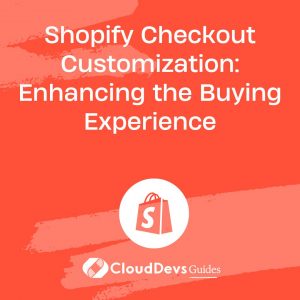Shopify Checkout Customization: Enhancing the Buying Experience
In the dynamic world of e-commerce, where every click and interaction matters, the checkout process stands as the pinnacle moment of truth. It’s the make-or-break point where a potential customer decides whether to seal the deal or abandon their shopping cart. As a Shopify merchant, understanding the significance of checkout customization is crucial for crafting a seamless and engaging buying experience. In this comprehensive guide, we’ll explore the intricacies of Shopify checkout customization and unveil strategies to elevate your store’s conversion rates and customer satisfaction.
Why Checkout Customization Matters
The checkout process serves as the final gateway between browsing and buying. It’s where user experience intersects with conversion optimization, making it a critical aspect of your e-commerce strategy. Studies have shown that even minor improvements in the checkout flow can lead to substantial increases in conversion rates. By customizing your Shopify checkout, you can address pain points, build trust, and differentiate your brand in a crowded marketplace.
Key Elements of Customization
1. Streamlined Flow
A cluttered and cumbersome checkout process is a surefire recipe for cart abandonment. Streamline the flow by removing unnecessary steps and minimizing form fields. Each additional click is an opportunity for customers to second-guess their purchase decision. Opt for a one-page checkout layout or a condensed multi-step process to keep things simple and intuitive.
2. Brand Integration
Your checkout pages should seamlessly integrate with your brand’s visual identity. Customize the color scheme, typography, and imagery to create a cohesive brand experience from start to finish. Consistency breeds familiarity and trust, reassuring customers that they’re in the right place.
3. Personalization
Tailor the checkout experience to each customer’s preferences and behavior. Leverage Shopify apps to offer personalized product recommendations, discounts, or shipping options based on their browsing history or purchase patterns. A personalized touch can significantly enhance engagement and conversion rates.
4. Transparency
Transparency breeds trust. Be upfront about shipping costs, taxes, and return policies to avoid any last-minute surprises. Consider incorporating progress indicators or visual cues to keep customers informed about their current step in the checkout process. Clear and concise communication is key to instilling confidence and reducing friction.
5. Multiple Payment Options
Offer a diverse range of payment methods to accommodate different customer preferences. In addition to credit/debit cards, consider integrating digital wallets like PayPal, Apple Pay, or Google Pay for added convenience and security. By removing barriers to payment, you can capture a wider audience and minimize drop-offs.
6. Mobile Optimization
With the proliferation of mobile shopping, optimizing your checkout for smaller screens is imperative. Ensure that your checkout pages are responsive and touch-friendly, with large buttons and easy-to-fill forms. Conduct regular testing across various devices and screen sizes to identify and rectify any usability issues.
7. Security Measures
Prioritize the security of sensitive customer information by implementing SSL encryption and PCI compliance standards. Display trust badges and security seals prominently on your checkout pages to reassure customers of their data protection. A secure checkout instills peace of mind and fosters trust in your brand.
Real-World Examples
1. Allbirds
Known for their minimalist approach to design, Allbirds’ checkout process is a testament to simplicity and elegance. With clean layouts and intuitive navigation, they prioritize frictionless usability above all else.
2. Warby Parker
Warby Parker’s checkout pages seamlessly blend style with functionality. Through custom illustrations, on-brand messaging, and clear calls-to-action, they deliver a cohesive brand experience from browsing to checkout.
3. Zappos
Zappos excels in transparency and trust-building throughout their checkout process. By prominently displaying shipping and return policies, along with customer reviews and ratings, they eliminate uncertainties and reassure shoppers at every step.
External Resources
For further insights on optimizing your Shopify store, check out these external resources:
- Shopify’s Guide to Checkout Customization
- Optimizely’s E-commerce Checkout Best Practices
- BigCommerce’s Tips for Increasing Conversion Rates
Conclusion
In the fast-paced world of e-commerce, where competition is fierce and attention spans are fleeting, optimizing your Shopify checkout is not just a recommendation—it’s a necessity. By implementing the strategies and insights shared in this guide, you can transform your checkout process from a mere transactional gateway into a powerful conversion engine. Remember, the key to success lies in continuous testing, iteration, and a relentless commitment to delivering exceptional customer experiences.
Table of Contents









